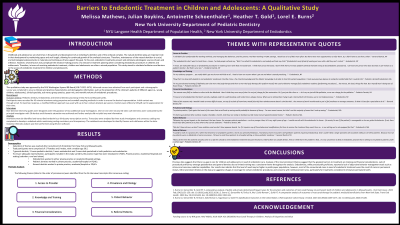Pulp Therapy
364 - Barriers to Endodontic Treatment in Children and Adolescents: A Qualitative Study


Melissa E. Mathews, DMD (she/her/hers)
Pediatric Resident
New York University, New York, NY
Long Island City, New York, United States- JB
- AS
Antoinette Schoenthaler, EdD
NYU Langone Health
- HG
Heather T. Gold, PhD
NYU Langone Health
- LB
- LB
Lorel Burns, DDS
NYU
New York, New York, United States - LF
Lauren M. Feldman, DMD, MPH
Postdoctoral Program Director
NYU College of Dentistry, Pediatric Dental Department
New York, New York, United States
Presenting Author(s)
Co-Author(s)
Research Mentor(s)
Program Director(s)
Purpose: This study aimed to elucidate facilitators and barriers to the access of endodontic treatment for children and adolescents.
Methods: This qualitative study utilized in-depth, semi-structured interviews with general dentists, pedodontists and endodontists working in different clinical and geographic settings to explore factors influencing treatment planning and provision of endodontic therapies for children and adolescents. Practitioners in New York State and Massachusetts were recruited for this study. Recorded interviews were de-identified and transcribed. Data were analyzed using thematic analysis.
Results: A saturation of themes was reached after 26 interviews: 7 general dentists; 11 pedodontists; 6 endodontists; 2 dual-trained specialists. Clinicians reported that the majority of pediatric patients that they encounter, requiring endodontic treatment, was resultant from caries on permanent molars. The following themes emerged as the most prominent impacting access to care: Clinical training; Patient behavior; Financial considerations. Pedodontists and general dentists reported a lack of clinical training for endodontic procedures and a dearth of endodontists in their area willing to either treat pediatric patients; or accept public-payer insurance. Endodontists reported a lack of time or armamentarium for behavior management and gaps in coverage for certain endodontic procedures relevant to the treatment of immature permanent teeth.
Conclusions: Children and adolescents needing endodontic treatment in the permanent dentition often fall through the cracks. Identifying factors influencing access to care is important for addressing this problem. This research is the initial step to identifying areas that may inform policy and curriculum, in order to better maintain the natural dentition of pediatric patients.
Identify Supporting Agency and Grant Number: Research supported by the National Institute of Dental & Craniofacial Research of the National Institutes of Health under Award Number K01DE028591 (PI, Lorel E. Burns). The content is solely the responsibility of the authors and does not necessarily represent the official views of the National Institutes of Health.

.jpg)